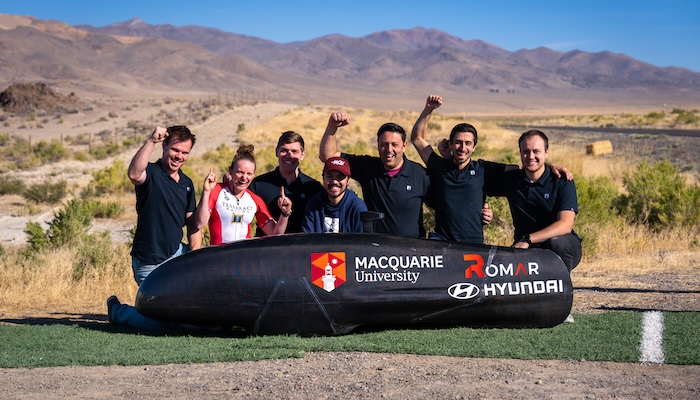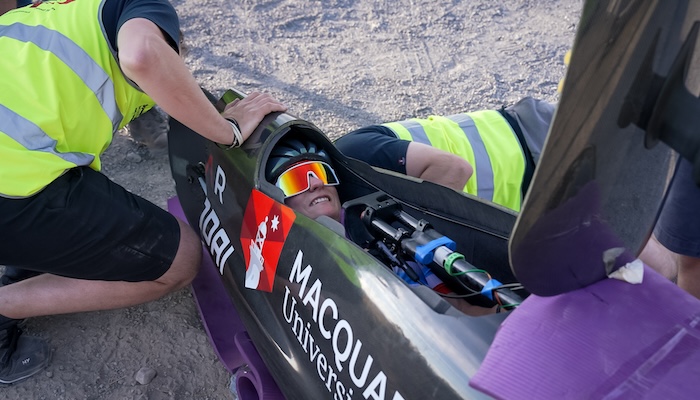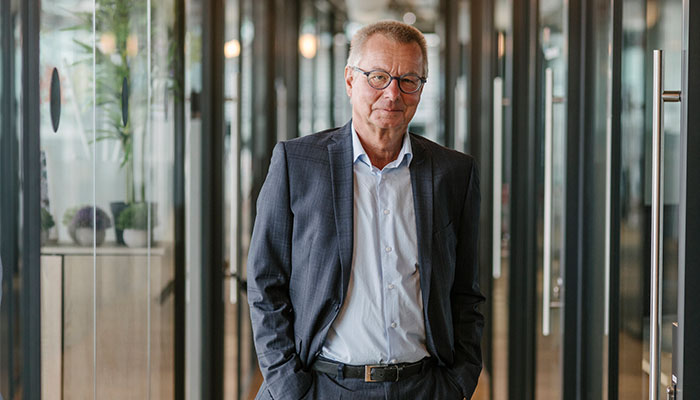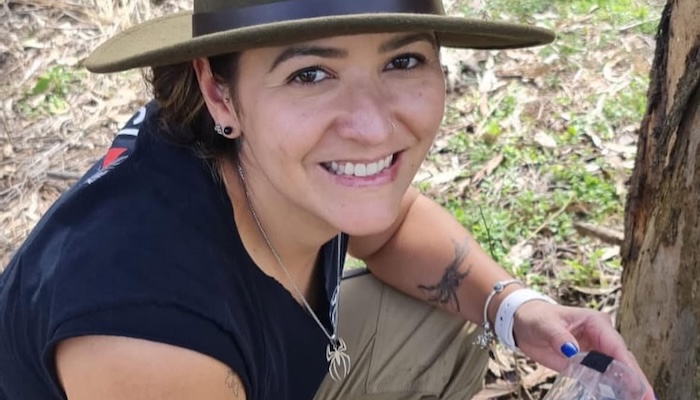In the vast Nevada desert, on a stretch of route 305 dubbed one of the world’s straightest and smoothest roads, the MQ Speed team made history, with their custom-built vehicle smashing two world records at the 2024 World Human Powered Speed Challenge.
Winners are grinners: the MQ Speed team celebrate after the win.
Six undergraduate engineering students made the trek to Battle Mountain, Nevada; another 10 or so were part of the build team that developed the sleek, bullet-shaped, aerodynamic vehicle they named MQ2.
For the students involved, the MQ Speed project is more than just a race on a desert road in the United States – it’s a career-defining experience.
“With MQ Speed, I’m putting the things I learn in my degree into practice,” says team member Ella Forrest, a second-year mechanical engineering student.
“Learning about aerodynamics and then helping design a super aerodynamic bike – it just shows you the possibilities,” says Ella, who hopes to one day be track side for the annual speed challenge.
MQ Speed has competed at Battle Mountain since 2017 and was the first Australian team to contest the event, which sees teams from across the world converge in the desert town in a quest to beat a range of human-powered land-speed records.
Students gain invaluable experience when they’re part of a real-world project with live deadlines and under racing pressure.
Dr Sammy Diasinos, Senior Lecturer, Mechanical Engineering at Macquarie’s School of Engineering, heads the project, drawing on six years’ experience as a Formula 1 race engineer.
“Students gain invaluable experience when they’re part of a real-world project with live deadlines and under racing pressure,” Dr Diasinos says.
Preparing the vehicle
Students learn to use simulation tools in their mechanical engineering course, including computational fluid dynamics (CFD). MQ Speed Team students apply the tools to rework and evolve constant iterations and evolutions of the shape of the bike.
The result is a vehicle so aerodynamic it can reach speeds approaching 100 km/h powered solely by human legs.
In Sydney, the team spent more than six months building MQ2, using 3D body scanning to tailor the vehicle for their race rider, professional track cyclist Lizanne Wilmot, who has ranked in the world’s top 100 in both sprint and keirin events.

Tight fit: Lizanne Wilmot in the aerodynamic, bullet-shaped bike.
During speed trials the team use live telemetry systems developed by the students to monitor the vehicle’s performance and safety so they can stop immediately if they spot any issues.
Before shipping the vehicle to Nevada, students tested it using wind tunnels and even ran a few trials on the runway of a small airport on the NSW Central Coast.
Battle Mountain
The vehicle that carried Wilmot to victory is a marvel of student engineering. MQ2 is a fully enclosed recumbent tricycle, custom-built by the team to minimise aerodynamic drag.
It required a leap of faith by Wilmot, trusting in the student engineers before climbing into the vehicle and lying on her back while the team placed the enclosing case over her.
“There are no windows, I look through a periscope with two cameras at the top, so I’m basically looking at screens and hoping I’m seeing exactly what's going on outside,” says Wilmot. Riders have an acceleration zone enabling them to reach maximum velocity, before being timed over a 200-metre distance.
Sami Beaumont, who is soon to complete his degree, was tasked with giving the challenge vehicle a push-start – but it’s the team’s custom build and on-site design modifications which really count.
He believes the challenge experience will give him a real advantage when he enters the industry. “Helping to set two world records with MQ Speed will definitely help my prospects,” Sami says.
But even after all the groundwork, the road to victory wasn't smooth this year; despite a few earlier runs at record-breaking speeds, wind conditions around Battle Mountain disqualified numerous record attempts, using up a lot of energy, time and opportunities.
It took a week of punishing trial runs, where the MQ Speed team pushed the limits of human-powered speed, to break two world records on the same day.
Duct-taped into the MQ2, Wilmot set a new world record in the women’s 600/200 category, reaching a speed of 63.3 km/h after a short 600-metre run-up.
Later, on the very last run of the series, as the sun dropped behind the hills and the gusting Nevada winds stilled, Wilmot and MQ2 shattered the women's Flying 200 record by an impressive 5 km/h, setting a new world record of 96.8 km/h.
Battle ready: The MQ Speed team at Battle Mountain, Nevada.
Groundwork
The victory is all the sweeter for student Julius Bommers, who has been part of the MQ Speed team for three years.
“It's amazing just to be at Battle Mountain after years of work, but even better to be going home with two world records,” Julius says.
Ella Forrest says that since joining MQ Speed a couple of months ago, her passion for engineering has been reignited.
“I started by just learning about the bike – just the CAD model is quite intimidating, it’s a very complex machine. Now I’m learning how to use all the fancy tools and helping out.
“I assumed all the parts were made externally so I was surprised to find almost every single part was made by students, including using composites to make the whole carbon fibre shell,” Ella says.
This involved building a mould using a custom-built computerised machining tool (CNC).
Students in MQ Speed aren’t designing theoretical models – they’re building real, record-breaking machines, says Dr Diasinos. It is a unique way for students to fast-track their engineering education.



